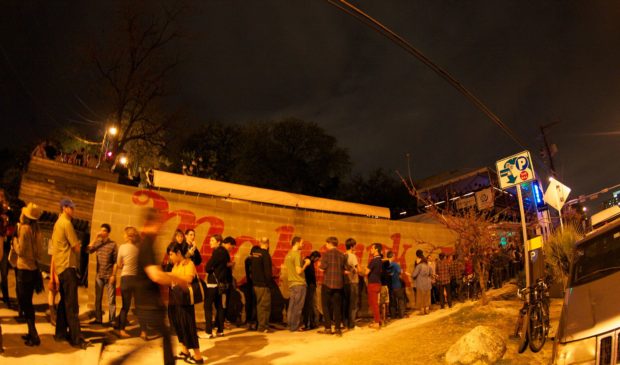Red River proponents seek policy ‘champion’ following live music report
Tuesday, June 20, 2017 by
Chad Swiatecki Streetscape improvements, greater attention to safety and partnerships with nearby community organizations are some of the steps needed to keep the Red River Cultural District a hub of live music, according to a recently completed study on the area.
The technical assistance panel from the Austin chapter of the Urban Land Institute spent much of last fall examining the development pressures, public safety concerns and other issues facing the cluster of 13 venues and clubs hospitable to original live music.
In April, the Austin Monitor obtained a nearly complete version of the report, which stated that the district is “currently in the ‘11th hour’ regarding the ability to comprehensively maintain the health of its live music scene.” The panel points out that there is optimism since city leaders, business owners and other stakeholders have stepped up in a number of ways over the past three years to address the threats to Austin’s live music economy.
The panel’s action plan is much the same as the April version, advising the following steps:
- Extend weekend outdoor music curfews, which is already allowed under a pilot program
- Take steps to improve safety for patrons and employees in the district
- Address homelessness issues such as drug use and prostitution near venues
- Establish best practices among venues to improve their business and operating margins
- Utilize the now-delayed “agent of change” policy to reduce noise issues with surrounding buildings
- Increase venue owner involvement in like-minded organizations to open resources and partnerships
- Push for streamlining of the city’s permitting and licensing processes
- Partner with the Waller Creek Conservancy to create a distinct experience in the district
- Take steps to make the district more eligible for city- and state-funded programs
- Explore public-private partnerships to encourage venue preservation
- Improve the streetscape to make the area more inviting to visitors
Some steps are already underway, with Mayor Pro Tem Kathie Tovo putting forth a resolution to install more trash cans and planters and improve lighting in key parts of the district. Also, the city’s Economic Development Department is conducting a survey of how to address the illicit activities concentrated in an alley off Red River Street just north of Seventh Street.
An observation that the area homeless population has outgrown the nearby Austin Resource Center for the Homeless, necessitating a “containment or relocation” strategy, is acknowledged as a difficult but unavoidable reality for the area. City and social services leaders are focusing on solutions for the situation at the ARCH, but no firm plan has developed yet.
Nicole Klepadlo, program manager for the Soul-y Austin business district incubator that has helped organize merchants in the area, said the panel gives city leaders and others the hard data needed to put together plans to save what is seen by many as Austin’s most important live music hub.
Klepadlo said the panel study fits together with the city’s 2015 music census and the policies created from Mayor Steve Adler’s Music & Creative Ecosystem Omnibus.
“It’s an opportunity to take a complex situation and put recommendations on the table that have come from the private sector,” she said. “We’ve seen things in other communities that give us a plan for how to move forward, and the panel outlines things that apply to (City) Council or work being done interdepartmentally.”
David Steinwedell, executive director of the Urban Land Institute Austin, said simplifying the city’s permitting process will have a positive effect aside from possible venue preservation because doing so would lower the barrier to entry for other hopeful business owners wanting to open a club along Red River Street.
He said one variable that remains uncertain is the possibility of finding a so-called “champion” for the preservation effort who can marshal the efforts of various business owners, rally private sector interest, and navigate city and state bureaucracies to move forward with relevant pieces of policy.
“I do believe that unless there’s someone who has the trust of the venue and property owners and who knows how to handle all of the issues involved, things are more difficult without that person,” he said. “I’m not sure there’s anyone that comes to mind, but there are good people out there with All ATX and South by Southwest who get what the area needs and understand that area has to be viable all year round.”
Photo by Nash Cook (https://www.flickr.com/photos/nashcook/5524995908) [CC BY-SA 2.0], via Wikimedia Commons.
The Austin Monitor’s work is made possible by donations from the community. Though our reporting covers donors from time to time, we are careful to keep business and editorial efforts separate while maintaining transparency. A complete list of donors is available here, and our code of ethics is explained here.
You're a community leader
And we’re honored you look to us for serious, in-depth news. You know a strong community needs local and dedicated watchdog reporting. We’re here for you and that won’t change. Now will you take the powerful next step and support our nonprofit news organization?









